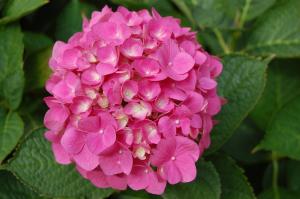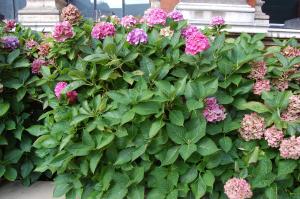
Hydrangea macropyla flower (17/09/2011, London)
Position: Full sun to Partial shade
Flowering period: Blooms repeatedly
Soil: Moist
Eventual Height: 3m
Eventual Spread: 3m
Hardiness: USDA Zones 4a-9b
Family: Hydrangeaceae
Hydrangea macropyla, a fast growing deciduous shrub with a rounded growth habit. Its stems emerge from the ground and rarely branch, they have a straw tan colour and often die back in winter. The flower buds are set at the end of the branches. The leaves are large and opposite with serrated margins,coarsely textured, and a glossy medium leaf green colour. They have stout petioles about 25mm in length. The leaves turn pale yellow in autumn, and are not ornamentally significant. The hermaphrodite flowers can be pink, purple, white or blue in colour and are 2cm in diameters. The individual flowers make a broad corymb and are very showy and look like large mopheads formed by tightly clustered individual florets up to 15cm across. The fruit of the plant is a dry cusp shaped capsule and is not ornamentally important.
H. macropylla, commonly known as Mophead Hydrangea, French Hydrangea, Bigleaf Hydrangea and Hortensia, is native to Japan. Hydrangea blooms will either be pink, blue, purple to white depending on the pH dependent mobilization and uptake of soil aluminum into the plants. Hydrangeas were introduced into the UK around 1788.The name Hydrangea is derived from the Greek term hydor meaning ‘water’ and aggos meaning ‘jar’ which refers to the plants cusp shaped fruit. The name macropyla is derived from the Latin term meaning big leaf.

Hydrangea macropyla (17/09/2011, London)
The landscape architect may find this plant useful in commercial planting schemes due to its sturdy nature, striking foliage and showy flowering. It looks good when planted en mass adding a bold textural quality to a scheme. It can withstand the salt of a maritime climate but dislikes strong winds. This plant will not flower in colder climates. This plant make a good informal hedging plant.
Ecologically this plant is attractive to bees, birds, mites and butterflies.
This plant prefers soil which is well drained and moist. It can withstand alkaline, neutral and acidic soils. It also can tolerate very acidic soils. The plant can cope with the salt derived form maritime exposure.
The Royal Horticultural Society has given their prestigious Award of Garden Merit to the varieties ‘Altona’ (1993), ‘Ami Pasquier’ (1993), ‘Blue Wave’ (1993), ‘Bluebird’ (1993) and 16 other varieties.
Maintenance: This plant requires little maintenance. If pruning is required it should be carried out before August to ensure the plant flowers the following season. This plant will also respond to harsh pruning and can be cut back to old wood if required.

